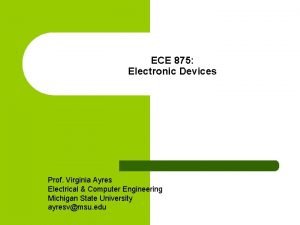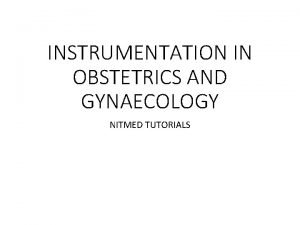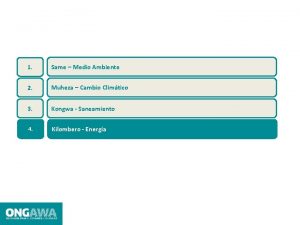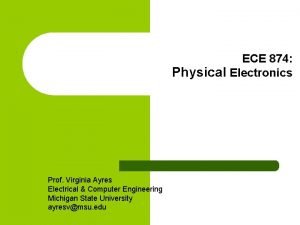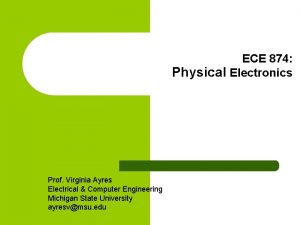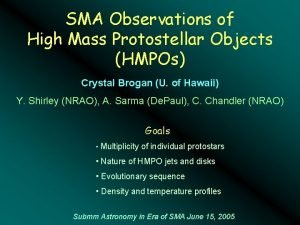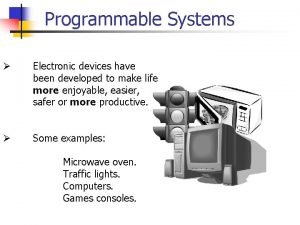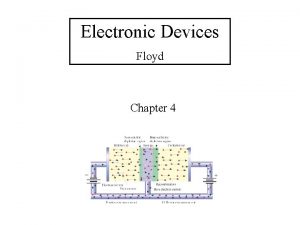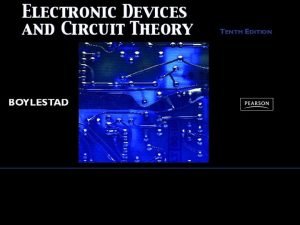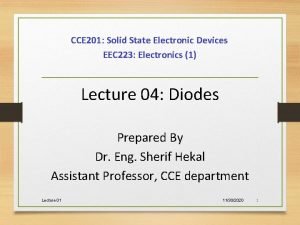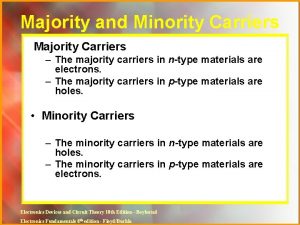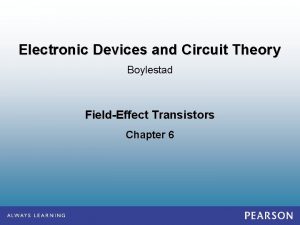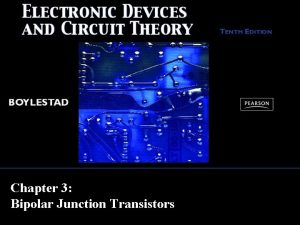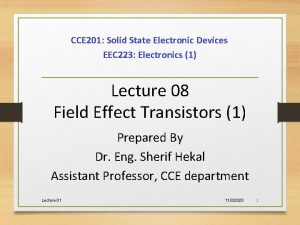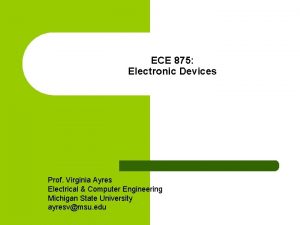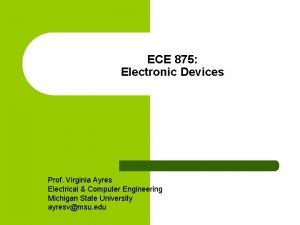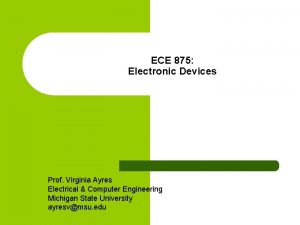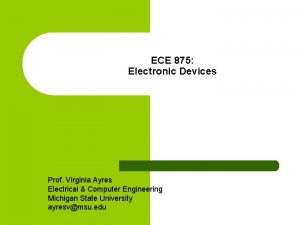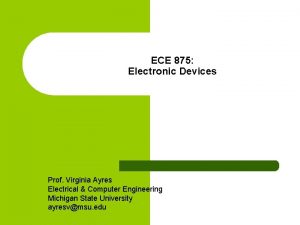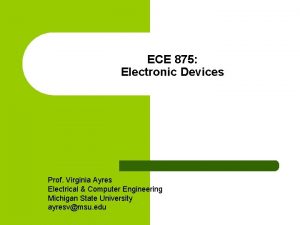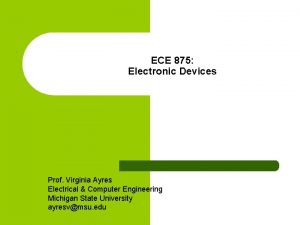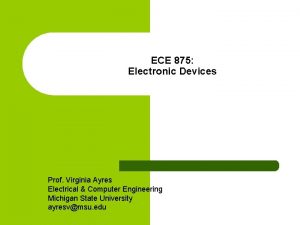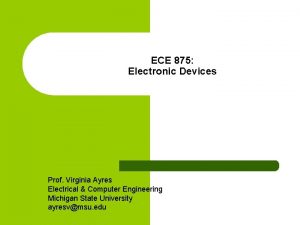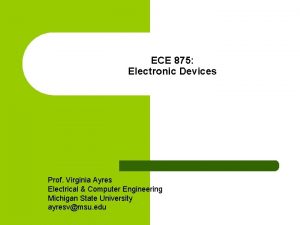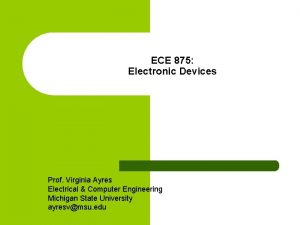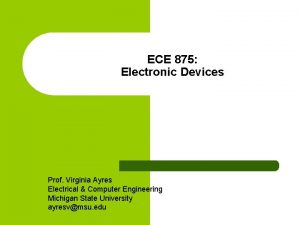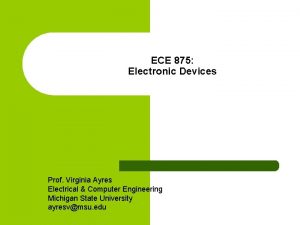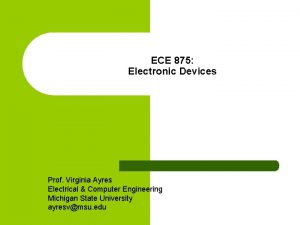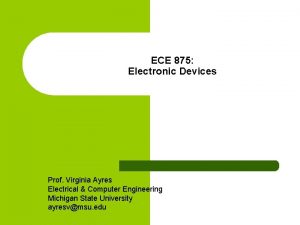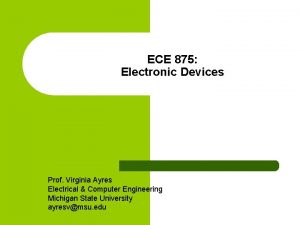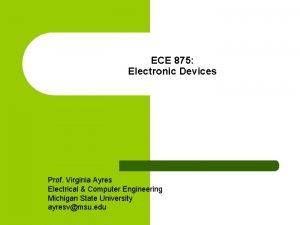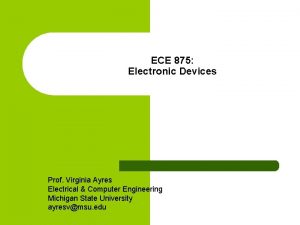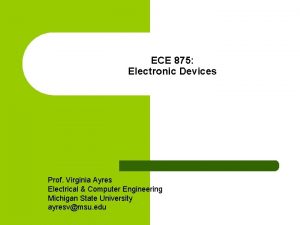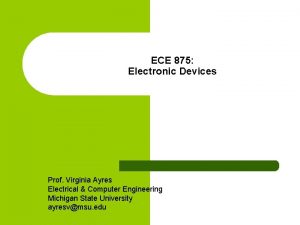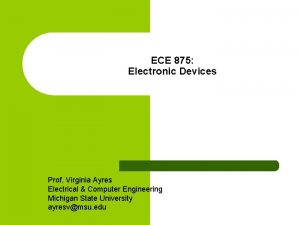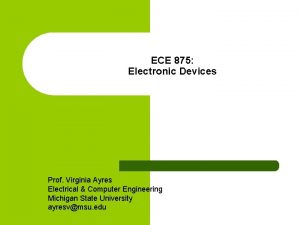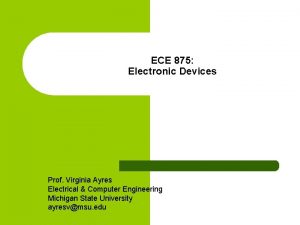ECE 875 Electronic Devices Prof Virginia Ayres Electrical




























- Slides: 28

ECE 875: Electronic Devices Prof. Virginia Ayres Electrical & Computer Engineering Michigan State University ayresv@msu. edu

Lecture 36, 09 Apr 14 Chp 06: MOSFETs Aspects of realistic MOSFET operation (n-channel p-substrate) Comment on 2 D mobility m Use of field oxide in CMOS Short channel effects on ON operation: • high E (y) => velocity saturation => lower IDS • micron-scale = worst • nano-scale = not so bad • scaling Good test for future ON/OFF operation: sub-threshold (not fully ON) swing VM Ayres, ECE 875, S 14

In the charge sheet and constant mobility approximation: ID Mobility is assumed to be constant However: It is a different value than 3 D bulk mobility VM Ayres, ECE 875, S 14

Lecture 36, 09 Apr 14 Chp 06: MOSFETs Aspects of realistic MOSFET operation (n-channel p-substrate) Comment on 2 D mobility m Use of field oxide in CMOS Short channel effects on ON operation: • high E (y) => velocity saturation => lower IDS • micron-scale = worst • nano-scale = not so bad • scaling Good test for future ON/OFF operation: sub-threshold (not fully ON) swing VM Ayres, ECE 875, S 14

Use CMOS (complementary metal-oxide-semiconductor FET) or NMOS design to reduce power consumption. +- +-

Use CMOS (complementary metal-oxide-semiconductor FET) or NMOS design to reduce power consumption. +- Wikipedia - A high voltage on the gates will cause the n. MOSFET to conduct and the p. MOSFET to not conduct while a low voltage on the gates causes the reverse. This arrangement greatly reduces power consumption and heat generation. +- However, during the switching time both MOSFETs conduct briefly as the gate voltage goes from one state to another. This induces a brief spike in power consumption and becomes a serious issue at high frequencies. VM Ayres, ECE 875, S 14

Another issue: Coulomb forces are distance dependent and spatially they last forever. So charges on a 1 st gate can influence the channel under the 2 nd gate. +- +- VM Ayres, ECE 875, S 14

Block with an oxide called the “field oxide” = more Si. O 2: +- +- VM Ayres, ECE 875, S 14

CMOS: OFF -+ -+ ON VM Ayres, ECE 875, S 14

Working tools: Channel/ Drain to Source Linear, saturation and intermediate forms ID Channel/ Drain to Source Potential associated with E-field across oxide: VM Ayres, ECE 875, S 14

1 st term in VFB: Given: both gates are n+ poly Si, which acts like a metal -0. 98 V VM Ayres, ECE 875, S 14

2 nd term in VFB: Qinsulator = Qm + Qot + Qf + Qit Given: Qf/q = 1011 Assume: Qm = Qot = Qit = 0 for this insulator under these operating conditions Therefore: Qinsulator = 1011 x 1. 6 x 10 -19 C And: VM Ayres, ECE 875, S 14

Next term: 2 y. B: VM Ayres, ECE 875, S 14

Next term: QD/Cox: VM Ayres, ECE 875, S 14

Goal: want minimum isolation VT = 20 V VM Ayres, ECE 875, S 14

Goal: want minimum isolation VT = 20 V Set = VM Ayres, ECE 875, S 14

Lecture 36, 09 Apr 14 Chp 06: MOSFETs Aspects of realistic MOSFET operation (n-channel p-substrate) Comment on 2 D mobility m Use of field oxide in CMOS Short channel effects on ON operation: • high E (y) => velocity saturation => lower IDS • micron-scale = worst • nano-scale = not so bad • scaling Good test for future ON/OFF operation: sub-threshold (not fully ON) swing VM Ayres, ECE 875, S 14

Goal: • More MOSFETs/CMOSs = more computer capability. Therefore make each MOSFET /CMOS smaller. Current CMOS: 22 nm node. Node VM Ayres, ECE 875, S 14

Problem: make channel length L shorter and MOSFET device performance deteriorates (see RHS). Why is this? Small L = “short channel” VM Ayres, ECE 875, S 14

Problem is with mobility/velocity: Charge sheet + constant mobility approximation Linear, saturation and intermediate forms ID Constant mobility assumption: <vel> = m E (y) VM Ayres, ECE 875, S 14

m <vel> E VM Ayres, ECE 875, S 14

Problem is with mobility/velocity: We assumed that <vel> = m E (y) meant a linear function of E (y). This is only true for low VDS (low bias). Realistically: VM Ayres, ECE 875, S 14

Problem is with mobility/velocity: ECE 474: “velocity saturation”: <vel> 105 V/cm E ext E (y) that increases along L VM Ayres, ECE 875, S 14

At high E (y)-field near Drain, have a velocity saturation effect that has nothing to do with pinch in the channel. <vel> E (y) that increases along L VM Ayres, ECE 875, S 14

Result of velocity saturation: RHS: velocity saturation occurs at lower VDS than that required for the channel pinch due to development of the depletion regions at the Drain end Small L = “short channel” High E -field in channel large VDS drop across a physically small L VM Ayres, ECE 875, S 14

What to use for mobility m now: <vel> n = 2 empirical velocity saturation of electrons in Si channel for moderate doping E (y) that increases along L VM Ayres, ECE 875, S 14

What to use for mobility m now: <vel> n = 1 empirical holes in Si channel for moderate doping n = 1 is also a mathematically simpler approximation for the n = 2 curve for electrons E (y) that increases along L VM Ayres, ECE 875, S 14

What to use for mobility m now: <vel> Two straight lines and avoid the point where they cross is another simpler approximation for the n = 2 curve for electrons E (y) that increases along L VM Ayres, ECE 875, S 14
 Virginia ayres
Virginia ayres Virginia ayres
Virginia ayres Jean ayres
Jean ayres Obstetrics instrument
Obstetrics instrument Jean ayres
Jean ayres Rusty and the ayers rockettes
Rusty and the ayers rockettes Natasha ayres
Natasha ayres Ayres locales
Ayres locales Ayres
Ayres Ayres
Ayres Hill 875 today
Hill 875 today Pasal 875 kuhperdata
Pasal 875 kuhperdata 800 yuvarlanan sayılar
800 yuvarlanan sayılar Notacion de intervalo ejemplos
Notacion de intervalo ejemplos Round 763 to the nearest hundred
Round 763 to the nearest hundred Sma-875
Sma-875 0 875 dibagi 1 1/4
0 875 dibagi 1 1/4 Hasil dari 0 625 per 0 875 adalah
Hasil dari 0 625 per 0 875 adalah Northern virginia seo
Northern virginia seo Scrip exchange
Scrip exchange Electronic news gathering and electronic field production
Electronic news gathering and electronic field production Programmable electronic devices
Programmable electronic devices Floyd
Floyd High frequency model of bjt
High frequency model of bjt Solid state electronic devices 7th solution chapter 4
Solid state electronic devices 7th solution chapter 4 Difference between majority and minority carriers
Difference between majority and minority carriers Boylestad
Boylestad Electronic devices and circuit theory
Electronic devices and circuit theory Solid state electronic devices ppt
Solid state electronic devices ppt
